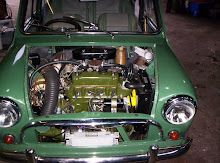The remaining component in the ignition system—if we exclude the ignition switch and the battery—is the ignition coil, which converts the low-voltage current from the battery into the high-tension current that is needed to produce a spark at the plug points.
The ignition coil is a sealed, oil-insulated unit containing two windings, the primary—a relatively heavy winding consisting of a few hundred turns of wire which carries the battery current—and the secondary, which con¬sists of many thousands of turns of fine wire, wound beneath the primary winding around an iron core. When the engine is running, current flows through the primary windings but is interrupted, at the instant at which each spark is required, by the opening of the contact points in the distri¬butor which form, in effect, an automatic on-off switch driven by the engine.
This induces a very high current in the secondary winding—it may reach a peak of 30,000 volts—but in practice the voltage continues to rise only until it is sufficient to cause a spark to jump across the sparking plug gap. The voltage required depends on a number of factors, such as the compression pressure existing in the combustion chamber at that moment, the air-fuel ratio of the mixture, the sparking plug temperature and the width of the gap.
The coil is the one item in the ignition system that usually requires little or no attention, apart from keeping the external surface clean—particu¬larly the molded cap. Remember that a current which reaches a peak of many thousands of volts will always try to find a leakage path from the central terminal to one of the low-tension terminals or to the earthed metal case of the coil. Moisture or greasy dirt is very liable to form such a conducting path.
A coil may appear to be perfectly satisfactory when cold or for a short period after the engine has been started, but may develop a partial or complete open-circuit in the windings when it has become thoroughly warmed-up, causing misfiring or ignition failure. As the coil will resume its normal action as soon as it cools down, this can often prove a very elusive fault to diagnose. When special test equipment is not available the best plan is to substitute temporarily a coil that is known to be in good condition.
Thursday, 15 October 2009
THE IGNITION COIL
Posted by Info Mini Cars at 02:25
Subscribe to:
Post Comments (Atom)


0 comments:
Post a Comment